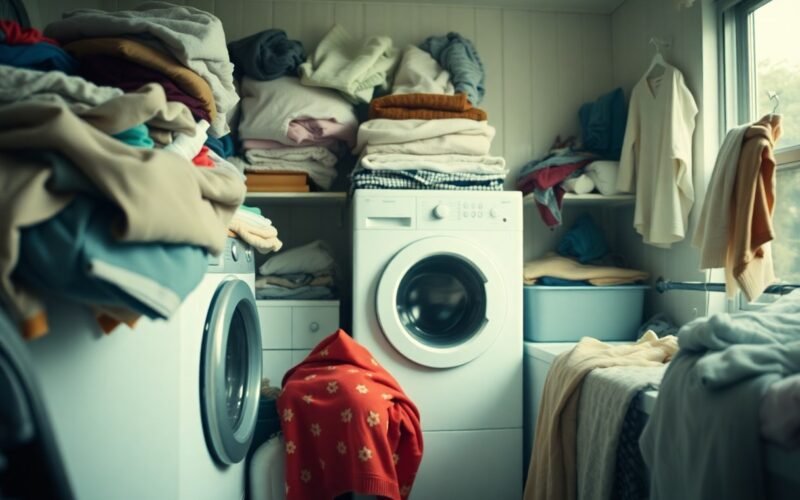Laundry day can often turn into a series of missteps that damage your clothes and waste your time. You might not realize it, but you could be making simple mistakes that lead to unnecessary wear and tear on your favorite pieces. For instance, are you washing your clothes in the wrong temperature or overloading your machine? To help you avoid these pitfalls, we’ve identified the top five errors you might be making. For more insights, check out this article on 11 Laundry Mistakes That Are Ruining Your Clothes.
Key Takeaways:
- Washing clothes in cold water can help preserve fabric quality and save energy, but some items may require warmer temperatures for effective cleaning.
- Overloading the washing machine can prevent clothes from getting properly cleaned and rinsed, leading to odors and detergent buildup.
- Ignoring care labels on clothing can result in shrinkage, color fading, or damage, so it’s important to follow the manufacturer’s instructions for wash and dry settings.
The Common Pitfalls of Sorting Laundry
Sorting laundry is more than just separating darks from lights; it involves understanding the nuances of fabric types and colors. Neglecting to properly sort your laundry can lead to unwanted consequences, such as fabric damage or color bleeding. Taking a moment to categorize your items accurately can save you from costly mistakes and extend the life of your clothing.
Ignoring Fabric Types
Many people overlook the importance of understanding fabric types when sorting laundry. Different materials require varying washing conditions to maintain their quality. Choose your washing settings based on the fabric to prevent shrinkage and damage.
- Cotton: Tolerates high heat, ideal for whites.
- Delicates: Require gentle cycles to avoid tears.
- Wool: Needs cold water and should be laid flat to dry.
- Polyester: Can withstand heat but may cling if dry cleaned.
- Silk: Requires cool water and a gentle touch.
Assume that taking a few moments to check the tags can save your garments from premature wear and tear.
| Fabric Type | Recommended Care |
| Cotton | Hot cycle, can bleach |
| Delicates | Cold cycle, gentle detergent |
| Wool | Cool cycle, lay flat to dry |
| Polyester | Warm cycle, avoid high heat |
| Silk | Cold wash, air dry |
The Misunderstood Color Code
Color sorting is often misinterpreted, leading to laundry disasters that could have been avoided. For example, assuming that all dark colors should be washed together can result in unintentional dye transfer, ruining lighter fabrics. Light colors and whites should be washed separately to preserve their brightness.
Many believe that segregating items solely by color is sufficient. However, specific shades can bleed when mixed together, like red and white, leading to a pink catastrophe in your wash. In reality, you should also factor in the intensity of colors and the fabric types when sorting items to minimize the risk of fading or unwanted transfers. Don’t ignore the labels and heed the instructions—they often contain valuable insights that prevent laundry mishaps.
The Detergent Dilemma: More is Not Always Better
Your laundry detergent can make a world of difference, but using more than necessary can backfire. Some people mistakenly believe that doubling the amount of detergent will yield cleaner clothes, however, this often leads to excess suds and inadequate rinsing. Striking the right balance ensures your clothes are thoroughly cleaned while avoiding the pitfalls of detergent build-up, which can actually attract dirt and leave your laundry feeling grimy.
Understanding Detergent Dosage
The Impact of Residue on Fabrics
Excess detergent can leave behind residues that cling to your fabrics, making them feel stiff and less vibrant. This residue can accumulate over time, resulting in dull colors and diminished fabric quality. In fact, washing with too much detergent affects your clothes’ longevity, causing wear and tear that could have been avoided. Regularly checking your washing machine for detergent build-up and running a maintenance cycle can help minimize these negative effects.
Temperature Temptations: When to Go Hot or Cold
The right water temperature can make all the difference in your laundry routine. Hot water is best for whites and heavily soiled items, as it helps to lift stains and kill germs. Cold water is ideal for dark colors and delicate fabrics, minimizing the risk of fading and shrinking. If you’re still unsure, check your garment labels for specific instructions or refer to our guide on the 5 Common Laundry Mistakes That You Should Absolutely … for more insights.
Temperature Guide
| Hot Water | Best for whites, towels, and bedding. |
| Warm Water | Good for synthetic fabrics and colors that are not prone to bleeding. |
| Cold Water | Ideal for dark colors, delicate fabrics, and lightly soiled clothing. |
The Science Behind Temperature Settings
Your laundry’s cleanliness hinges on temperature. Warm and hot water effectively deactivate detergents, allowing them to lift stains and sanitize fabrics. However, as temperatures rise, so does the risk of damaging delicate threads and color bleeding. That’s why balancing temperature based on garment type is key to preserving your favorites and ensuring freshness.
Effects of Temperature
| Hot Water | Eliminates bacteria and allergens, suitable for sturdy fabrics. |
| Cold Water | Conserves energy and maintains fabric integrity. |
Avoiding Damage: Fabrics and Color Fading
Using high temperatures on the wrong fabrics can result in fading or even irreversible damage. For instance, delicate fabrics like silk and lace should always be washed in cold water to maintain their texture and hue. Additionally, bright and dark colors are prone to bleeding; thus, sticking to cold water can help to keep your clothes looking vibrant and new.
Always be aware of the fabric content before choosing your wash temperature. Natural fibers like cotton can typically tolerate hot water, while synthetics like polyester benefit from lower temperatures to avoid distortion. By tailoring your wash cycles to suit your clothing, you not only preserve the fabric quality but also extend the life of your wardrobe. Mixing different temperature settings for different loads can yield significant results, ensuring that you’re not just cleaning clothes, but protecting your investment in fashion.
Timing Is Everything: The Perils of Overloading the Machine
Overloading your washing machine may seem like a time-saver, but it can lead to a host of problems that compromise your laundry results. Cramming too many items into the drum not only increases wear and tear on the machine but also ensures that your clothes come out less than clean. This excessive load limits the movement and action of both the water and detergent, leaving residue on your clothes and creating an environment for unpleasant odors to develop.
The Effects of Overloading on Cleaning Efficiency
An overloaded washer operates at a disadvantage, leading to a significant drop in cleaning efficiency. When clothes are packed too tightly, the detergent doesn’t disperse properly, resulting in a lack of suds that are crucial for breaking down dirt and grime. Moreover, the water can’t circulate effectively, leaving areas of the fabric untouched. Studies have shown that overloaded machines can fail to remove up to 30% of stains, meaning your hard work in washing yields disappointing results.
Balancing Load and Cycle Duration
Finding the right balance between load size and washing cycle duration is key to effectively cleaning your laundry. Overfilling can cause longer wash times and stress on the machine, while underloading can waste water and energy. Aim to fill your washer to about three-quarters full, leaving enough space for items to move freely. Additionally, consider adjusting the wash cycle based on the load size; smaller loads may require less intensive cycles while larger ones can handle standard settings without compromising cleanliness.
Optimizing load size and cycle duration can significantly elevate your laundry experience. By keeping the drum appropriately filled, you allow for full agitation—enabling each item to come into contact with detergent and water effectively. Adjusting cycle settings according to the weight and fabric type enhances efficiency, ensuring that you achieve the best clean while conserving resources. A well-balanced load not only saves time but extends the lifespan of your machine, making your laundry routine smoother and more effective.
The Myths of Drying: Air vs. Dryer
Understanding the myths surrounding drying methods can significantly enhance your laundry routine. Many believe that air drying is always the superior choice due to its energy efficiency, but the truth is that both air and dryer methods have their distinct advantages and drawbacks. Some fabrics may retain their shape and color better with air drying, while the dryer can provide speed and convenience. The key is knowing the specific needs of your fabric and circumstances. For a deeper examine effective laundry practices, check out these 5 laundry mistakes to avoid.
When Air Drying is Beneficial
Opting for air drying is particularly beneficial for delicate fabrics, such as silk or lace, which are prone to damage in the dryer. You can also prolong the life of activewear by air drying, as high heat can break down elastic fibers over time. Furthermore, air drying can help reduce static cling and is eco-friendly, saving energy and reducing your carbon footprint. In scenarios where time allows, air drying can be a gentler solution for many garments.
Common Misconceptions About Dryer Usage
Many people think using a dryer is the quickest and easiest method for drying clothes, but this common misconception often overlooks efficiency aspects. For instance, some fabrics are susceptible to shrinking or fading when subjected to high heat. Additionally, the belief that all dryers work equally well fails to acknowledge differences in dryer technology, venting, and drying times. Understanding how your specific dryer operates and its settings can help you optimize your drying experience and protect your clothes.
Some individuals falsely assume that tossing clothes into the dryer for any duration will yield satisfactory results. In reality, dryer settings vary for fabric types. For example, a gentle cycle can significantly reduce wear on delicate items, while a higher heat level is suitable for thicker fabrics. Awareness of these details can prevent damage and preserve the quality of your laundry. Additionally, using dryer balls can enhance air circulation and reduce drying time, making your dryer more efficient.
Summing Up
From above, you have learned about the common laundry mistakes that could be affecting the cleanliness and lifespan of your clothes. By taking care to sort your laundry properly, avoiding overloading the washer, using the right detergent, and selecting appropriate wash settings, you can significantly improve your laundering experience. Additionally, keeping your appliances clean will ensure optimal performance. Making these simple adjustments in your routine can lead to fresh, well-maintained laundry that looks and feels better. Start implementing these tips today to enhance your laundry day outcomes!
Q: What are some common laundry mistakes people make that can affect clothing quality?
A: One common mistake is overcrowding the washing machine. When too many clothes are packed in, they don’t have enough space to move around, which can lead to ineffective cleaning and potential damage. Another mistake is skipping pre-treatment for stains, which can make them harder to remove later. Additionally, using the wrong detergent or too much detergent can lead to residue build-up on clothes and in the machine.
Q: How does washing clothes in hot water affect their lifespan?
A: Washing clothes in hot water can speed up wear and tear, especially for delicate fabrics. Heat can cause fibers to break down more quickly, leading to faded colors and weakened materials. It’s often better to wash with cold or warm water for regular loads, as this can help maintain the integrity of the fabrics while still providing effective cleaning.
Q: Are there any mistakes related to drying clothes that I should be aware of?
A: Yes, one common drying mistake is using high heat settings for all types of fabrics. This can lead to shrinkage and damage to delicate items. Also, leaving clothes in the dryer for too long can lead to wrinkles and the need for ironing. It’s advisable to check the fabric care labels and to remove items from the dryer while they’re still slightly damp, allowing them to finish air drying to minimize damage.




